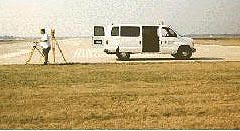
|
|
The Global Positioning System (GPS) includes a constellation of 24 satellites, launched and operated by the United States Air Force, which transmits radio signals. When used according to standardized procedures, GPS receivers can determine positional coordinates to centimeter-level accuracy anywhere on the surface of the Earth. The first GPS satellite was launched in 1978, and the system was declared fully operational for civilian applications in December 1993. National Spatial Reference System Augmenting this space-based system is a network of Continuously Operating GPS Reference Stations (CORS), which serves as the foundation for the National Spatial Reference System (NSRS). NSRS is a coordinate system that defines position (latitude and longitude), elevation, distance and direction between points, strength of gravitational pull, and how these values change over time. This information is essential for ensuring the reliability of transportation and communication systems, boundary and property surveys, land record systems, mapping and charting, and many scientific and engineering applications. NSRS provides the positional integrity that allows use of GPS for many modern positioning applications.
Continuously Operating Reference Station Network The National Geodetic Survey (NGS), part of NOAA’s National Ocean Service, coordinates a network of more than 400 CORS stations that receive GPS radio signals 24 hours a day, seven days a week. The GPS data collected at these stations allow GPS users to determine more accurate positions through computation after the data are collected. Numerous federal, state, and local government agencies, as well as universities and commercial organizations also operate CORS stations. They are established and maintained according to rigorous standards developed by NGS to provide the most accurate GPS information available. CORS standards cover factors such as location and stability of the GPS-receiving antenna, and transmitting and computing GPS data. CORS data are used by meteorologists to monitor the distribution of moisture in the atmosphere for forecasting severe weather events such as tornadoes, hurricanes, thunderstorms, and snow storms. CORS data are also used by atmospheric scientists to monitor the distribution of free electrons in the ionosphere. Rapid changes in this electron distribution are due to solar and geomagnetic storms. These changes can affect satellites, aircraft, certain radio communications, and even power distribution grids on Earth.
GPS data are widely applied. CORS site positions and GPS data help to assess the integrity of buildings and other structures by noting positional changes caused by land subsidence and lateral shifting. Using GPS data in conjunction with aerial photography, the latitude and longitude of any point on land can be located to within about 30 cm (1 foot). This precision enhances the usefulness of geographic information systems (GIS). A GIS assembles information about a geographic area into different layers of data, such as the location of utility lines, roads, streams, and buildings. Regional planners can use the layers individually or in various combinations to determine how to improve traffic flow, merge construction with existing utility systems, or protect the public from natural disasters. Precise positioning for most of the nation’s infrastructure—transportation, utility, energy, and communications systems—depends on the combined data provided by GPS, GIS, and the NSRS.
One application of GPS is producing airport obstruction charts, which are used for safe air navigation. These charts show obstructions to air navigation, aircraft movement and apron areas, prominent airport buildings, navigational aids, and roads and other features in the airport vicinity. The foundation elements for the surveys used to produce these charts are permanent survey monuments, which are positioned based on GPS observations. The data generated by these surveys are used to develop instrument approach and departure procedures and to determine maximum takeoff weights for civil aircraft.
|
|
|||||||||||||||||||||||||||||
|
|||||||||||||||||||||||||||||||
|
Revised January 27, 2004 | Questions, Comments? Contact Us | Report Error On This Page | Disclaimer | User Survey |



